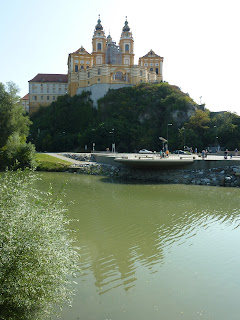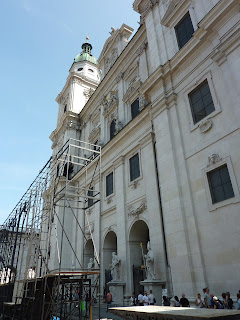A day trip to Salzburg (Austria) was an optional excursion on our Danube river cruise. We elected this option because Salzburg was high on our list of places to see and we are glad we made that decision. The downside of selecting the day trip to Salzburg was that we had very little time in Linz, but one of the positives beyond Salzburg itself was that we got to at least briefly experience Mondsee on the way to Salzburg. Even though we spent far more time in Salzburg than we did in Linz or Mondsee, we were still only able to experience a small fraction of what Salzburg ("salt castle" / "Festival City") offers.
Salzburg is located on the Salzach River. This river is a tributary river to the Inn River and so its waters eventually become part of the Danube River (at Passau, Germany).
We started our tour of Salzburg on the New Town side of the Salzach in the Mirabell Gardens (gardens of Mirabell Palace [Schloss Mirabell]).
The Pegasus Fountain seemed to be one of the more popular spots in the Mirabell Gardens.
We used the Makartsteg Bridge to cross the Salzach River to the Old Town side of Salzburg. That bridge had numerous padlocks on it and these are discussed in online resources such as "Love Lock Pedestrian Bridge" and "Salzburg Bridge Attracts Lovers and Locks."
The Old Town portion of Salzburg was what I had pictured in my mind when I thought of Salzburg based on "The Sound of Music" and other sources of information on Salzburg that I had previously encountered. The Getreidegasse is described as "the bustling heart of Salzburg’s Old City."
Wolfgang Amadeus Mozart was born at No. 9 Getreidegasse in 1756 in "Hagenauer Haus."
I was not able to get good photographs of Salzburg Cathedral (Dom zu Salzburg) because of work being done in front of it.
St. Peter's Monastery and Cemetery were popular with the tourists. It's no wonder given that St. Peter's Cemetery has been called "one of the most beautiful cemeteries in the world" and given the late scene in "The Sound of Music" that was inspired by this cemetery.
We have found in our first trip to Europe (and in other trips) that some of the best photographs and memories of a city can be captured from high vantage points. This was the case in Salzburg, where we took photographs from Hohensalzburg Fortress (Festung Hohensalzburg).
The easiest approach to the sprawling Hohensalzburg Fortress is via FestungsBahn, a furnicular that takes less than one minute to go from Salzburg up to Hohensalzburg Fortress.
Hohensalzburg Fortress is huge. I only show a single photograph here, but more can be found at this Hohensalzburg Fortress Pictures and Videos site.
Although Hohensalzburg Fortress and the Fortress Museum are interesting to see in its own right, the views from it are even more spectacular.
Residence Square (Residenzplatz Square) and its Residence Fountain (Residenzbrunnen) attract many photograph-taking tourists!
While at Residence Square, we visited the Panorama Museum. That museum's page describes the 360 degrees panoramic painting that visitors can view from a platform, "As far as the eye can see: the cycloramic painting by Johann Michael Sattler gives us a view onto the City of Salzburg and its environs around the year 1829." The platform within the 360 degrees and highly detailed panoramic painting is the centerpiece and highlight of the museum, but it also has photographs, drawings, and text describing Salzburg's history (particularly fires and rebuilding). See the TravelAdvisor reviews to get a good idea of what to expect and not expect from this museum.
Before leaving Salzburg, we visited a few of its shops and sampled the "Original Salzburger Mozartkugel."
I purchased small books with photographs and light descriptive text of most cities we visited on this trip. For Salzburg, I purchased a copy of Colorama's 14th Edition (July 2016) of Salzburg: The Festival City set amidst a Gorgeous Alpine Countryside." This book features a section "Surrounding Areas of Salzburg" ("Day Trips to Surrounding Areas") that includes some photographs that make me wish we had time to visit those areas outside of Salzburg. These areas include Kehlsteinhaus (The Eagle's Nest), the Salzkammergut, Giant Ice Caves in Werfen, Liechtensteinklamm, Hohenwerfen Fortress, and Hohe Tauern National Park.
When we were reserving and planning this trip, we had high hopes for Salzburg and it was definitely worth the bus ride to see it and spend time in Salzburg. I just wish we had more time to see a few more things in Salzburg and in its surrounding area (including Mondsee).














































































